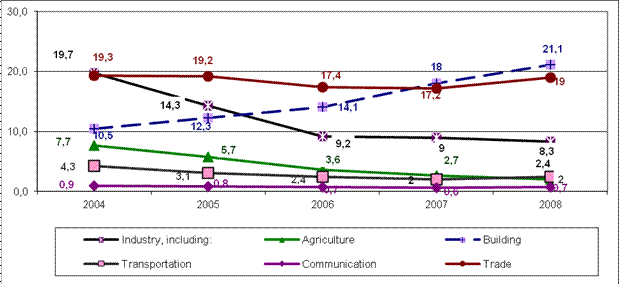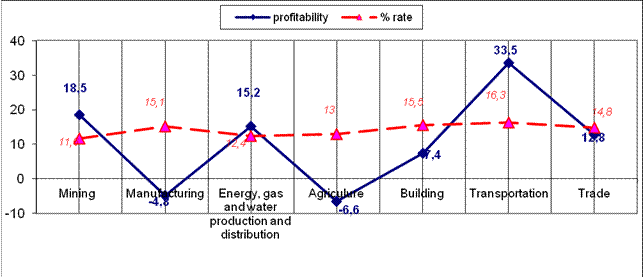
Note - drafted by author with respect to [1]
Graph 1. Dynamics of GDP Growth and Bank Loans in Economy in Republic of Kazakhstan from 2004 to 2008
The slow growth of bank loans has influenced the decrease of the production volume index in industry. To a considerable degree the decrease of the production volume index during this period occurred in the building sector - 16%, which was caused by the crisis in mortgage lending and real estate price reduction. As for the industry in general, the index dropped up to 8% whereas in manufacturing industry - up to 12% for the whole period.
As a positive one can be regarded the strong tendency of the growth of long term crediting in general structure of bank loan fund the size of which grew up to 4 934 906 million tenge or 14% from 2004 to 2008 making up 5 921 883 million tenge or 80% by the end of the period mentioned above. At the same time the analysis of the dynamics of long term crediting in the light of the branches of economics shows the reduction of crediting of enterprises in all branches of economy except for the building sector (graph 2).

Note - drafted by author with respect to [3]
Graph 2. Dynamics of Long Term Bank Crediting in Different Branches of Economy from 2004 to 2008
As it is seen in the graph only in building sector there is both the biggest weight of long term crediting in the structure of bank loan fund in branches of economics - 21.1% and its increase during the whole period - 10.6%. This tendency was caused by a high business activity in the building sector of the country both before the world crisis and after it, because almost all started projects were continued. The biggest decrease of long term crediting was in industry - up to 11.4% and agriculture - up to 5.7%.
The analysis of the long term bank crediting in different branches of economy in the light of the units of crediting represents the dominant part of loans granted by the banks used to complete circulating assets the volume of which 14.9% decreased during the investigated period and made up 26.1% by the end of 2008. Insignificant part of loans granted by the banks used for basic assets did not agree with the needs of the enterprises in reequipment because there was still seen a fair level of accumulated depreciation by the end of 2008 - 40%. As soon as this information is given according to average statistic data of the Agency of Statistics of Republic of Kazakhstan round the country in general, in taken separately regions the level of wear of basic assets is slightly higher.
Not all of the enterprises can afford bank loans because of the increase of bank recourses cost by +1.0% up to 7.6% at the increase of straddle by +0.6% up to 6.2 %. At such high loan interest rates the low level of profitability of domestic enterprises, particularly industrial ones, leads to a permanent situation of impossibility not only to cover bank loans but even to have an opportunity to get them (graph 3).

Note - drafted by author with respect to [3]
Graph 3. Comparative Dynamics of Level of Profitability and Loan Interest Rates in Different Branches of Economy in 2008
The evidence of insufficiently effective interaction, which must be directed to get a maximum effect for each of the parts (to reach so-called a synergetic effect), is also a rise of overdue loan overdraft and the deterioration of loan fund of bank sector. The part of standard loans in loan fund of the banks of Kazakhstan fell up to 13.2% from 2004 to 2008, the part of doubtful loans grew up to 11.1%, the part of NPL (the part of idle loans, the calculation on the basis of doubtful loans of the fifth category and hopeless loans) grew up to 2.7% during the same period by the end of 2008, at the recommended value - not higher than 5%. The biggest amount of overdue loan overdraft in crediting belongs to: JSC "Kazkommertsbank" - 202.93 billion tenge, JSC "BTA Bank" - 157.87 billion tenge, JSC "Halyk Bank" - 160.92 billion tenge [4].
The benefit and earnings yield of bank activity along with the problems of the quality of assets and their liquidity considerably decreased. At the same time the drop of yield during the period of the world crisis from 2007 to 2008 in the bank sector was 85.9%, which is 18.1% more than in the real sector of economy. The main reason of this drop was an intense growth of expenses of supplies formation and reappraisal (mainly at the expense of negative reappraisal of the securities).
According to the analysis of dialectics of the given sectors it follows that the fundamental characteristics of the bank sector finally are determined by the condition of real sector and the economy of the country as a whole. Therefore the condition of the bank sector in general sufficiently shows the reached level of market development of the national economy.
Having examined the modern tendencies of the development of the interaction of bank and real sectors of economy, from the point of view of both the commercial banks and the real sector enterprises we have a possibility to define the potential of sectors interaction with the help of the SWOT analysis:
Strong points:
- Comparatively big part of bank assets in GDP.
- Growth of weight of long term crediting in the structure of bank loan fund.
- Consolidation of bank resources in general due to preemptive growth of natural and juridical person deposits.
Weak points:
- Slowdown of crediting growth, increase of foreign debt, insufficient capitalization and liquidity, and also the decrease of quality of assets of bank sector, as a result of the influence of the world financial and economical crisis.
- Inadequacy of bank crediting potential and needs of enterprises in crediting resources for renewal of basic assets in time and capacity constraints.
- Limited variety of promising resources of formation and consolidation of bank resources and absence of effective mechanisms to transform savings into investments.
- Inadequacy of the rates of loan bank rates and the level of enterprise profitability in real sector (inaccessibility of loan resources for the enterprises).
- High straddle rates at the formation of interest rates caused by a high level of crediting risk and sharp decrease of the level of yield of the bank sector under the crisis conditions.
- Increase of part of overdue loan overdraft in bank loans in such branches as building, industry and agriculture, which led to the growth of the part of idle loans in general structure of the deterioration of loan fund of bank sector.
Threats:
- Formation of huge foreign debts of domestic banks raises the probability of liquidity decrease, crediting potential and financial consistency and reliability of banks, and also access of enterprises of real sector to bank resources, as the only real source of investment financing from the outside during the period of the crisis.
- Combination of factors which are on the side of enterprises (low profitability, increase of industry risks, growth of overdue loan overdraft, etc.) calls for re-orientation of the bank sector in the direction of other operations in speculative character without taking into consideration the interests of real sector and economy in general.
- Combination of factors which are on the side of banks (limit of access to foreign fund sources because of big foreign debts, deficiency of fund sources, reduction and inadequacy of resources, reduction of long term and appropriate enterprise crediting) limits the access of potential borrowers in the person of enterprises of real sector to bank loans and decreases their business and investment activities.
- Excessive bank sector dependency on foreign fund sources reduces international crediting ratings of both the banks and the country in general, which firstly influences the trust of foreign investors to domestic banks.
- High risk level in bank sector which is connected with the liquidity crisis supports a high level of existence of idle resources in hoarding and their flow-out to the foreign bank accounts. The increase of the size of deposit guarantee of natural persons up to 5 million tenge to hold up the flow-out of deposit resources from banks does not correlate with real abilities. Endowment insurance fond has only about 50 million USD and this sum will be hardly enough to liquidate the deposits of the citizens in 20 biggest banks which is only 55% of all bank system.
- Today´s method to limit the usage of pension assets while investing them into different financial activities, as well as into bank deposits, limits the opportunity of their effective transition into real sector of economy.
Possibilities:
- The development of state and private partnership to provide harmonic cooperation of bank and real sectors of the economy in terms of uniting the resources and improving the effectiveness of methods of regulation and management of this process.
- Improvement of law currently in force in finding the principles of formation and function of the integrated corporate bodies (i.e. bank groups, financial and industrial groups) with the determination of clear and strict prudential standards concerning them from the direction of regulators, which will allow partly to solve the problem of weak bank resources and access of enterprises to inexpensive crediting resources.
- Maximum stimulation of domestic fond sources and formation of more conservative financial types of banks. Particularly the development of effective mechanism in usage of long term assets of pension funds and insurance companies with the adaptation of state guarantees of their safety with a view to use them further for a specified purpose.
- The usage of adequate complex state approach on the basis of combination of united political, economical and financial decisions while forming the system of interaction of bank and real sectors of the economy as a main motive force of the economical development of the country.
References
- News agency rating site - Standart&Poors - www.sandp.ru
- News agency statistics of RK site - http://www.stat.kz/
- News agency National Bank of RK - http://www.nationalbank.kz/
- Dzhasybekova L.N. "Crediting as the Basic Financial and Bank Instrument of Investing Economy of Country". Banks of Kazakhstan June 2009: 8-16.

